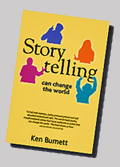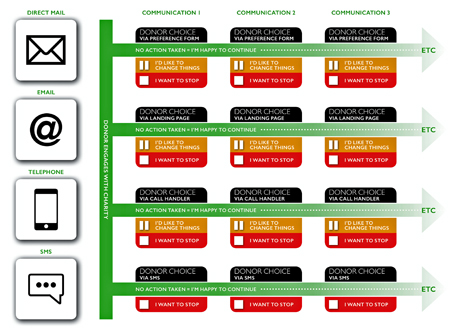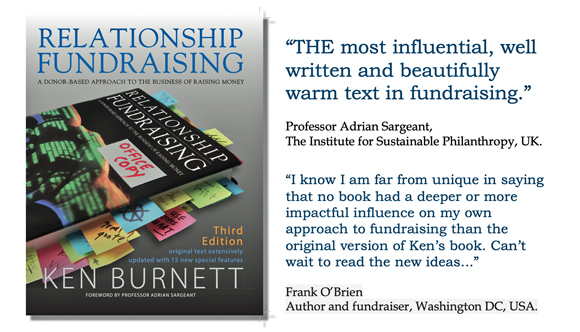| |
Opinion

From Jackie Fowler, chairman of the
Burnett Works agency, 
Tim Connor,
account director at Burnett Works, 
and Ken Burnett,
co-founder of the Commission on the Donor Experience.
Tim and Jackie are joint project owners for project 13 of the Commission on the Donor Experience. Managing preferences and giving donors choices.
This article first appeared on the UK Fundraising website on 28 Sept 2016. Giles Pegram’s commentary is scheduled to appear there, on 5th October.
Blog 10 October 2016.
To restore and consistently promote public trust and confidence, donors now need to be given and to achieve practical control of what they receive from the charities they support, or choose not to support.
Most donors would not wish a perhaps randomly made decision at the start of their relationship with a cause to restrict indefinitely the charity’s ability to contact them, even at a time of crisis or good news.
The welcome information that every donor receives should clearly inform them that they can control everything they are sent from now on, that in every future communication they will be given the opportunity to review their contact preferences
and to change these easily, as the donor wishes, or to leave contact preferences as they are.
 Storytelling can change the World Storytelling can change the World
is reviewed here and here and you can buy it here.
|
Last week saw the publication of NCVO’s long awaited report, Charities’ relationships with donors: a vision of a better future. We welcome its publication, particularly its sensible focus on ‘consent’, its mission to deliver the single objective stated on its cover, ‘…recommendations on how to enable donors to give consent’ and the confirmation that, for the time being at least, charities will not be obliged to follow a system of securing consent via ‘opt-in’.
While neither route is obligatory for charities, NCVO’s report suggests that consent can involve either opting-in or opting-out. We believe that any system based on opting in would be unnecessary, difficult to implement and contrary to the interests of both donors and the charities they support. It could have a catastrophic effect on charities’ income and prevent donors from hearing from charities they’d like to support.
Our belief is that an easy, clear system of opt-out through giving continuous donor choice is a better, simpler, more efficient and more effective way of offering donors meaningful control of their relationships with charities they choose to support. It gives donors all the control they need or would wish for, while actually helping rather than damaging fundraising. This article defines that better way and provides a step-by-step guide to its implementation.
The system we describe here, prepared for the CDE project Giving donors choices and managing preferences, will work well for both donors and for the charities they support. Indeed, there probably hasn’t been a better opportunity for fundraisers since the invention of regular giving.
Donor choice: the starting point
Continuous donor choice is an approach to putting donors in control of how they hear from the charities they choose to support.
For too long what donors receive from the charities they support has been entirely decided for them by fundraisers seeking to maximise income for their cause. Donors are sent what the fundraisers want them to receive, the fundraisers’ choices mainly driven by what they believe will most easily and quickly enable them to achieve their financial targets.
It’s obvious that this has to change. For donor choice to work well for both the donor and the fundraiser it has to start from the donor’s point of view. Fundraisers need to see the process through the donor’s eyes, to put themselves in their donor’s shoes whether the donor is new to the cause, has been supporting it for some time, or is even becoming inactive.
It is more than likely that most donors will not wish their exercising of communication choices to damage fundraising or to reduce charities’ ability to contact people who might support them. Most donors would not wish a perhaps randomly made decision at the start of their relationship with a cause to restrict indefinitely the charity’s ability to contact them, even at a time of crisis or good news. While giving may reduce in the short term there’s evidence to suggest that instead of damaging or restricting fundraising income, offering donors choices will increase retention, trust and the willingness to give. The long-term benefit of giving donors choices will be happier donors, better fundraising and enhanced fundraising results.
What follows is a detailed, step-by-step proposal for a system of genuine donor control driven by what most donors want – continuous donor choice.
Some key considerations
Charities always have to be guided by the concept of the truth, told well. At all times they must behave legally, decently, honestly and truthfully when communicating with donors and potential donors.
So a good question for the fundraiser to ask him or herself is, if my mother were a donor, how would I wish her to be treated? Donating to a charity should always be a voluntary act and a rewarding, pleasant experience. To restore and consistently promote public trust and confidence, donors now need to be given and to achieve practical control of what they receive from the charities they support, or choose not to support.
Continuous donor choice from the fundraiser’s point of view
How it works for new donors
• In their first contact the new donor is welcomed and given choices. If he or she doesn’t do anything the charity will send them communications that have been (hopefully carefully) selected and compiled by the fundraiser.
The welcome information that every donor receives should clearly inform them that they can control everything they are sent from now on, that in every future communication they will be given the opportunity to review their contact preferences and to change these easily, as the donor wishes, or to leave contact preferences as they are.
• If the donor wishes to change how they hear from the charity.
The donor can express a preference, or set of preferences, based on the choices he or she has been offered. Larger charities may offer a sophisticated, tailor-made range of choices. Smaller charities may offer fewer options, but the principles are the same. The scale and type of options are up to the charity but all must be practical, manageable and sustainable, all must offer donors the chance to increase, reduce or cease completely what they receive. In each communication donors should be given simple, easy-to-make choices and be invited to telephone or email the fundraising office if they have any issues or questions.
• If the donor wishes to stop hearing from the charity altogether.
The donor has made a clear decision. He or she wishes to opt out. This should always be respected. The donor will not hear from this charity again unless he or she decides to re-opt in by another means, at another time.
How it works for existing donors
• If the donor does not take action to change what the charity wishes to send them, or has been sending them.
The chance to change is offered in every communication so there should be no ambiguity that, if the donor does wish to change anything at all, he or she can easily do so. In the absence of any such notification, communications can therefore continue as before.
• If the donor wishes to change how they hear from the charity.
As the chance to change is offered in every communication the donor can easily inform the charity of his or her desires at any time.
• If the donor wishes to stop hearing from the charity altogether.
As the chance to opt out is offered in every communication the donor can easily inform the charity of his or her desire at any time.
These options must always be offered and always honoured.
How it works for inactive former donors
• If the donor continues not to respond to whatever the charity sends them.
It seems likely that fundraising charities will have a specific time-limited opportunity to re-engage and reactivate donors who for whatever reason have simply stopped not just giving but responding in any way. All reasonable efforts at reactivation can be employed by the charity as long as with each communication there is a clear and comprehensive opportunity for the donor to choose future communication preferences, including the full opt out. If after an agreed period of time there is still no response the charity may choose to consider that an indication of opt-out, so no further contact should be made. But as substantial numbers of donors mailed just once each year do re-opt in even after six or seven years, providing valuable support, it is to be hoped that an arbitrary time limit shorter that this will not be imposed on charities and donors – providing the continuous donor choice options are always offered, in every contact.
• If the donor informs the charity that he or she wishes to change how he or she hears from them.
Then he or she has effectively either chosen to reactivate themselves or has opted out.
For the full picture of how this works please see the panel article opposite, Continuous donor choice from the donor’s point of view. For more information on a charity that has implemented continuous donor choice successfully for more than 30 years, please see here, here and here.
© Jackie Fowler, Ken Burnett and Tim Connor, September 2016.
This article has been written in preparation for project 13 of the Commission on the Donor Experience, Giving donors choices and managing preferences.

|

Think of this as a traffic-light ’permission’ system dictated by the donor and flexible to his or her adjustments at any time.
NB SMS offers no preference choices other than the chance to stop or to continue to receive texts. Click on the image to enlarge.
CONTINUOUS DONOR CHOICE
FROM THE DONOR’S POINT OF VIEW
How you can keep control of how your favourite charities contact you.
To be a donor to any cause or charity you have to give a first gift. Here’s what’ll happen when you do.
Your gift can be anonymous, which involves nothing more than sending it in.
If you are willing to give the charity your name and address you will be asked to complete your details on a reply form (depending on the medium of communication used this information may be provided via the telephone, by SMS message, via email, or by some other means). Charities always prefer to have your contact details so that they can confirm safe receipt of your donation and tell you about the good things they’ll be able to do now, thanks to your support. And, if you are willing, to engage your future support, appropriately.
Because some see this last point as contentious, charities also want you to be in control of how and when they contact you and what about. So either in this first communication or when you receive an acknowledgement and a letter thanking you for your initial gift you will receive a further reply form which will also contain a number of choices you can make about how you would like the charity to communicate with you in the future, specifying how often, on what subjects and when you’d be willing for the charity to make contact. And even if you’d prefer the charity not to contact you at all.
The choices you’ll be offered include.
• Whether you want to receive the charity’s news for supporters. This will tell you about what the charity has done with the donations it receives and the kinds of difference your gift will make.
• Whether you wish to receive the charity’s regular appeals (most charities usually send four or more postal appeals each year, though this does vary from charity to charity).
• Whether you’d prefer to receive just one appeal each year. This will usually be sent in the period before Christmas but you might also be asked when might be the best time for you to receive that appeal.
• The charity might ask how you’d prefer to hear from them, for example by post, by telephone, by email, or by text to your mobile phone. Or, if you prefer, by none of these routes.
• Sometimes you’ll be offered choices on the kinds of information that you can receive, as well as the frequency. For example, information on certain selected projects, or detailed feedback on a project that interests you, or where your gift has made a difference.
• If you prefer not to receive any appeals you will always have the chance to opt out of further communication from the charity. Or to opt back in if you’d like to receive more. The choice is yours, always.
From now on each time that you hear from the charity (based on the choices you made earlier) you will be given the chance to change your preferences as you wish. So you will always be in control.
These or similar choices should be available to you whenever you hear from any charity, even if you’ve never supported that charity before. The charity will always respect your rights to the details you have supplied and will not sell, pass on, or alter your personal data without your permission.
• Other choices may be offered, depending on the capacity of the individual charity and the range of choices they wish to offer their donors.
Enjoy being a donor!
* • * *• * * * * • • * * * * • • * * * * • • * * * * •• * *
Giles Pegram CBE offers his donor’s view
A DONOR-CENTRED ALTERNATIVE TO OPT-IN
I can’t believe the publication of the NCVO report on ‘Donor Consent’ has received so little attention. I can’t believe that I am alone in thinking that mandatory opt-in was a possibility. Indeed, some have already acted assuming it was. Yet it isn’t. Why aren’t we shouting hurrah from the roof-tops?
I write what follows in a personal capacity, not as vice-chair of the Commission on the Donor Experience. But I do write thinking about the donor experience.
As a donor, I expect that when I give a donation, I will hear from the charity. Thanking me. Reporting back on what my donation has achieved, and, from time to time, asking me to give again, or increase my monthly gift. Why wouldn’t I? I have engaged with the cause. I want to feel good when I decide to give again, or when I increase my monthly gift. I want to feel good that my charity feels I am making a difference. If the charity simply swallowed my gift and didn’t give me further opportunities to give, I would be sadly disappointed. I would feel my charity didn’t want my support. So why did I give in the first place?
Mandatory opt-in is anathema. It is simply not a good response to a donor’s donation. As a donor –and again, speaking personally, I would find the requirement to tick a box in order to hear from the charity intrusive, bureaucratic and almost Kafkaesque. Who is paying for this intervention? A part of my gift?
I could go further, but I’ll refrain. As a donor, I might assume donors have been asked and this is what they’ve asked for. So I might acquiesce.
But, as a fundraiser, as far as I am aware, that isn’t true. Donors haven’t been asked. I’d find any suggestion of opt-in without asking donors extraordinary. Mandatory opt-in would have a catastrophic impact on giving, and on beneficiaries. Over the past months I have heard little discussion about the effect of all these sanctions on beneficiaries. Thank goodness the NCVO board and their working party are defining systems that would not require a mandatory opt-in. In their excellent blog Continuous donor choice: fundraising’s best opportunity in ages (see opposite) Ken Burnett, Jackie Fowler and Tim Connor have proposed a method of opt-out that is so comprehensive I would argue that it would work very much better than opt-in, in practice. Unlike mandatory opt-in, which I don’t believe is donor friendly, their proposal, continuous donor choice, is totally donor centric. It puts donors in charge of the communications they receive from their charities.
Furthermore, continuous donor choice is not a hygiene factor. It will have a totally positive effect on the donor. ’You have given to us. We love you. We would like you to be involved, but precisely as you would like to be.’
As a donor, if I got that message, I would have a ‘wow’ factor moment. The charity has handed control of the relationship to me. I am now an equal participant. Of course – and I’m not a psychologist – I’m going to say, ’yes, I like this’. Wouldn’t you?
So, again, please read the blog and proselytize. This issue must be forefront in every fundraiser’s mind. If you agree with the blog, please say so. Forward it. Tweet it. Put it on Facebook. Let it go viral.
The Fundraising Regulator must decide how to respond to the NCVO report. Please ensure that they at least consider the option of continuous donor choice. It really is good. It will give donors the best experience.
If you don’t agree, please say so. Passive silence can be taken as indifference, which for something this important would be unthinkable. This is too important to the future of fundraising not to have your say. Indeed, as the blog says, there probably hasn’t been a better opportunity for fundraisers since the invention of regular giving.
Giles Pegram CBE
• * * * • * * • • * * * * • • * * * * • • * * * * •• * *
Related links/earlier blogs:
• Donor-centred fundraising – are you prepared to take a leap of faith?
• A donor preference service that works, from the 1980s.
• Botton Village: giving donors choices.
• Botton Village: the Frances pack. * *
Home page | Current blogs | Article archive
DISCLAIMER: Please note, though Ken Burnett was joint initiator of the Commission on the Donor Experience (with Giles Pegram CBE) and is fully committed to helping it to achieve its goals, these views are his own, entirely (plus Tim’s and Jackie’s too, of course).

|






